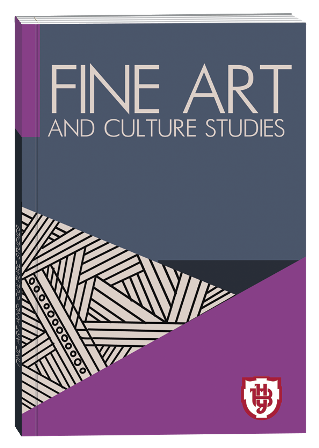KHARKIV VIDEO PRACTICES: PARALLEL ART PROGRAMS OF 2022–2023
DOI:
https://doi.org/10.32782/facs-2023-6-8Keywords:
video art, video practices, video installation, media art, contemporary Ukrainian art, Kharkiv art schoolAbstract
The article analyzes video practices of the Kharkiv artists in changing times of 2022–2023. It considers exhibition projects that use video art as a tool of visual activity and social interaction in the artistic environment which initiated the most influential artistic processes during the war in the front-line city of Kharkiv. Kharkiv video artists created reflection projects on traumatic historical experience turning video art into a powerful form of resistance. The importance of the topic lies in visual demonstration through the study of Kharkiv video practices as artistic reflections and the video technologies used in the visual space as a self-determination of an artist’s place in the conditions of war and the continuation of the Kharkiv artistic traditions of actionism. Methodologically, the author relies on the theoretical concept of the leading researcher of video art, Gene Youngblood, «Expanded Cinema», which talks about the destruction of visual narrative and the emergence of a new sequence in video art, as well as the fact that the author «dissolves» his own work in the screen projection due to the dynamics of the moving image. The latter provides the artist with a communication tool which combines visuality and self-awareness in new senses, as we see in Kharkiv video projects. The scientific novelty of the article consists in studying a number of iconic art shows and actions that were exhibited in underground premises, namely the video online broadcast «We came here because we live here», the exhibitions «In the Dark», «Liutyi», which reflect the Kharkiv artistic movements in the «NAvproty» gallery in the 90s. An analysis of the parallel art program in the center of contemporary art «Yermilov Centre» and the characteristics of video practices during the exhibition «The Personnel» was carried out. The personalities of the Kharkiv video art center were considered: Andrii Rachynskyi, Daniil Revkovskyi, Bella Logachova, Oleksandr Prysiazhnenko, as well as new student names from the KSADA, which were presented at the «Liutyi» exhibition. The author concludes that important components in Kharkiv video practices are artistic movements and the creation of parallel art programs and exhibition projects, which in their representative forms are reinforced by the conceptuality of the video art direction, provide various opportunities for the synthesis of arts and show visual practices of the artistic environment.
References
Алфьорова З. І. Відео-арт у дзеркалі мистецтвознавчого дискурсу. Культура України. Мистецтвознавство. Філософія. Вип. 18. 2007. C. 81–87.
Алфьорова З. І. «Паттерни бачення» Віктора Сидоренка: досвід трансформації сучасного мистця у контексті змін морфології візуального процесу. Вісник ХДАДМ. Х.: ХДАДМ, 2022. № 1. С. 192–206.
Бавикіна В. Репрезентація соціальних трансформацій в українському медіа-мистецтві. Грані. 2014. № 10. С. 97–100.
Вишеславський Г. Відео-арт. Сучасне мистецтво. 2009. № 6. С. 53–70.
Гончаренко Д. Практики використання відео у перформанс-арті. Сучасне мистецтво. 2014. № 10. С. 58–61.
Когут В., Патик Р. До питань методики розмежування відео мистецтва та відеодокументаціії (на прикладі відеоарту Львова 1989 – 2016 рр.). Актуальні питання гуманітарних наук: міжвузівський збірн. наук. праць молодих вчених Дрогобицького державного педагогічного університету ім. Івана Франка. 2021. Вип. 1, № 33. С. 40–49.
Павлова Т. В. Перша публічна виставка групи «Время» в Харкові: маніфест нового артмедіуму. Вісник ХДАДМ. Харків: ХДАДМ, 2020. № 3. С. 54–61.
Побожій С. І. Відеоарт як технологія само ідентифікації художника. Світогляд – Філософія – Релігія: зб. наук. пр. УАБС НБУ. Суми: УАБС НБУ, 2014. С. 119–128.
Пруденко Я. Люди з відеокамерами: міста та художні прийоми українського відео-арту 1990-х. Flashback. URL:https://issuu.com/mystetskyiarsenal/docs/flashback_catalog_mystetskyi_arsenal_2018?e=1355133735/92592715 (дата звернення: 5.07.2023).
Сидоренко В. Візуальне мистецтво від авангардних зрушень до новітніх спрямувань: розвиток візуального мистецтва України ХХ-ХХІ століть. Київ: ВХ [студіо], 2008. 190 с.
URL:https://uartlib.org/downloads/TerraIncognita5_uartlib.org.pdf. (дата звернення: 6.04.2023).
Соловйов О. Турбулентні шлюзи: зб. наук. статей. Ін-т проблем сучасного мист-ва АМУ. К.: Інтертехнологія, 2006. 192 с.
Kharkiv School of Photography. URL: https://ksp.ui.org.ua/uk/video/ (дата звернення: 16.09.2020).
Чепелик О. Імерсивні середовища в інсталяціях бієнале сучасного мистецтва Arsenale’2012. Сучасне мистецтво. 2012. Вип. 8. С. 354–365.
URL: http://nbuv.gov.ua/UJRN/S_myst_2012_8_35 (дата звернення: 10.04.2023).
Шумилович Б. Візуальна іронія та укрсуч мистецтво. Іронія: зб. статей. Львів: Литопис; Київ: Смолоскип, 2006. С. 78–92.
Carter C. L. Video Art: Cultural Transformations. The journal of Asian Arts&Aesthetics. 2014. Vol. 5. P. 9–22. URL:https://epublications.marquette.edu/phill_fac/523 (Last accessed: 12.09.2023).
Cubitt S. Videography Video media as Art and Culture. London: Macmillan Education LTD, 1993. 264 p.
Benjamin W. The Work of Art in the Age of Mechanical Reproduction. London: Penguin, 2008. 128 p.
Elwes C. Video Art A Guided Tour. New York: I. B. Tauris&Co Ltd, 2005. 225 p.
London B. Video/Art: The First Fifty Years. New York: Phaidon, 2020. 280 p.
Meigh-Andrews C. A History of Video Art. London: A&C Black, 2013. 408 p.
Rush M. Video Art. London: Thames&Hudson, 2007. 224 p.
Youngblood G. Expanded cinema. New York: E. P. Dutton&Co., Inc., 1970. 448 p. URL:http://monoskop.org/images/4/40/Youngblood_Gene_Expanded_Cinema_no_OCR.pdf. (Last accessed: 1.11.2020).







